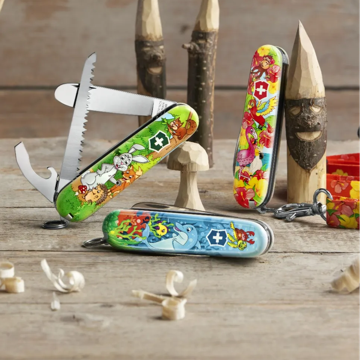
THE CARVING EXPERT
We talk to Felix Immler
An Interview with Felix Immler: carving expert, kids educator and author
Our very own Felix Immler is a trained machine mechanic, social worker and nature educator who works full-time as a pocket knife educator for Victorinox. He regularly posts pocket-knife and bushcraft videos on his Youtube channel and is the father of three children.
We sat down with Felix and asked him what his favourite knife is, why you can start teaching kids at a relatively early age and how, for a child, getting their first pocket knife is like being knighted.
Why are pocket knives so fascinating to kids?
“Because they seem dangerous, even if they aren’t really. They are what adults have in their pocket, so they must be interesting. And when you’re a kid and finally get one, it’s like being knighted – you feel like you’re grown up and you’re so proud to have one.”
What do you say to parents who worry pocket knives are dangerous for kids?
“They are no more dangerous than a bicycle or a skateboard. Kids just need to be taught how to use them. And they need to be interested in having one. Because it’s about more than just buying them a pocket knife; parents need to be familiar with handling them too. And the more the parents know about pocket knives, the easier it is for them to continue to teach their kids about them after the course.”
At what age can kids join your beginners’ course?
“From age five up. I teach them how to use a pocket knife properly, but they really need to be continuously monitored by an adult for a while afterwards. So nowadays, I very seldom offer courses just for kids. I have designed them for both parents and their kids, or teachers and their pupils, so that the process is continued under adult supervision. Learning needs to be repeated until the kids understand the importance of safety and what they can do with a knife.”
What do kids ask most often?
“Once they realise this is going to be a hands-on thing, it’s always: ‘Can we make a crossbow? Arrows?’ It’s always something they can throw or shoot. They are impatient and want to make things right away. But first they have to learn how to hold the pocket knife, how to open and close it safely. The basics need to come before anything else.”
WHAT IS YOUR FAVOURITE POCKET KNIFE?
“The Huntsman I got when I was 8. It was my first introduction to being given responsibility and it holds the history of my entire childhood up to today. I’ve lost and bought dozens more, but this knife is very special. It has the small blade, which is best for whittling and carving, the awl for making holes and the saw for working wood into smaller pieces.”
YOU HAVE WRITTEN BOOKS ABOUT CARVING AND MAKING CRAFTS WITH A POCKET KNIFE. WHICH ONE WOULD YOU SUGGEST STARTING WITH?
“’Crafting with the Pocket Knife" is an introduction, it contains the basics of what you can do with a knife. It can be done anywhere. "The Swiss Army Knife Book" takes the activities outside. It provides ideas on what to make outside with things you find in a forest – what’s known as "bushcraft" – as well as wilderness and survival techniques.”
WHERE DO YOU START WITH A GROUP OF KIDS?
“The first course always starts the same way: after they learn about safety and how to handle the knife, I get them to cut a long, sturdy branch from a hazel bush. I teach them to shave off the bark and make a sharp little point at one end. It’s a walking stick, and a prong to stick a sausage on to toast over a fire. It’s fun to watch how boredom is suddenly replaced by excitement. They’ve created their first tool with their first pocket knife. At this point even the most jaded child will ask hesitantly, ‘Can I take this walking stick home?’ And they flush with pride and excitement when I say: ‘Of course.’”



What is your favourite pocket knife?
“The Huntsman I got when I was 8. It was my first introduction to being given responsibility and it holds the history of my entire childhood up to today. I’ve lost and bought dozens more, but this knife is very special. It has the small blade, which is best for whittling and carving, the awl for making holes and the saw for working wood into smaller pieces.”
You have written books about carving and making crafts with a pocket knife. Which one would you suggest starting with?
“"Crafting with the Pocket Knife" is an introduction, it contains the basics of what you can do with a knife. It can be done anywhere. "The Swiss Army Knife Book" takes the activities outside. It provides ideas on what to make outside with things you find in a forest – what’s known as "bushcraft" – as well as wilderness and survival techniques.”
Where do you start with a group of kids?
“The first course always starts the same way: after they learn about safety and how to handle the knife, I get them to cut a long, sturdy branch from a hazel bush. I teach them to shave off the bark and make a sharp little point at one end. It’s a walking stick, and a prong to stick a sausage on to toast over a fire. It’s fun to watch how boredom is suddenly replaced by excitement. They’ve created their first tool with their first pocket knife. At this point even the most jaded child will ask hesitantly, ‘Can I take this walking stick home?’ And they flush with pride and excitement when I say: ‘Of course.’”
Official Website
All available products and the best browsing experience in one place
Stay up to date
Stories and offers, regularly in your mailbox.


